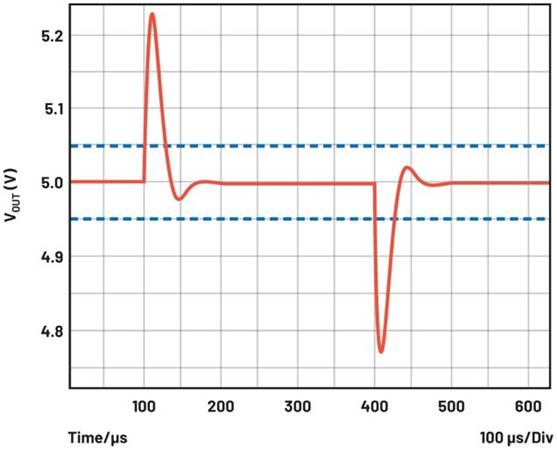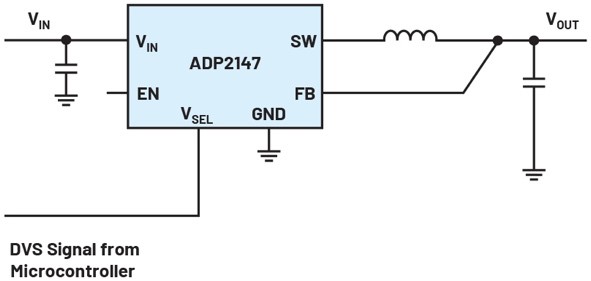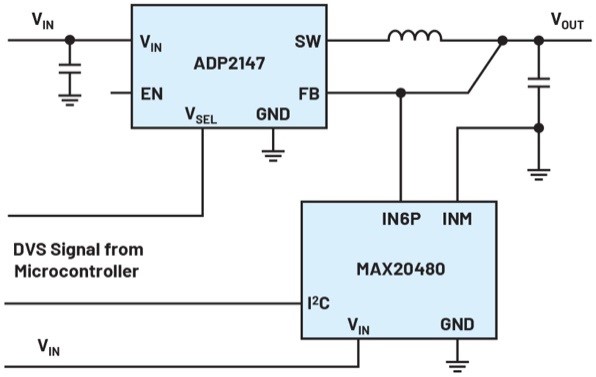Precision voltage regulation achieved through dynamic voltage regulation
Time:2023-11-02
Views:678
abstract
This article explores how to achieve precise voltage regulation through Dynamic Voltage Regulation (DVS). DVS is a process of slightly increasing or decreasing the output voltage based on expected load transients. This article introduces how to use specific ICs to achieve reliable voltage monitoring.
brief introduction
When strict adjustment of the power supply voltage is required, the DC voltage accuracy specifications in the switch regulator data manual can be used. The accuracy value is usually ± 1% or ± 0.5%. If the voltage converter uses an external resistance voltage divider in the feedback path, the tolerance of the resistance must be included in the voltage accuracy calculation. In addition, in addition to DC accuracy, dynamic voltage accuracy must also be considered. If a load transient occurs, i.e. the load suddenly consumes high current, the generated voltage may be lower or higher than the set point voltage, and then stabilize at the set point level. This behavior depends on the speed of the control loop. For applications that require strict regulation of power supply voltage, precision voltage is usually required during such load transients. Figure 1 shows the typical voltage response in the time domain after a load transient occurs. As you can see, 100 μ Connected to a load after s, 400 μ The load was disconnected after s.


Figure 1. Typical voltage response of power supply after load transient
The advantages of DVS technology
DVS has multiple advantages that help achieve higher precision voltage regulation. By utilizing DVS technology, the output voltage can be adjusted near the set point to compensate for load transients and provide stricter regulation.
As shown in Figure 1, the voltage fluctuation after load transient is usually many times higher than the DC accuracy limit of the power supply voltage. The dashed line in Figure 1 shows the 1% accuracy limit.
It is meaningful to use DVS to control these sometimes very high voltage fluctuations within the specified accuracy range. For example, when the load is low, it is assumed that a load transient will occur next to a high load. Therefore, before a load transient occurs, the output voltage will slightly increase (e.g. to 5.2 V). But the magnitude of the voltage drop will not change as a result. The voltage did not decrease from 5 V to 4.75 V, but from 5.2 V to 4.95 V. When there is a high load current, the voltage will slightly decrease because it is generally expected that the load will drop again at some point. This way, the voltage overshoot will not be so high.
The buck switch regulator circuit shown in Figure 2 is a simple DVS implementation scheme. For example, by applying a microcontroller signal to the VSEL pin, it indicates whether the generated voltage should be slightly increased. When using a simple DVS implementation scheme, the system must generate this instruction and provide it to the switching regulator. Some switch regulators implement more complex DVS systems. When using these systems, the various load thresholds for DVS switching can be directly programmed and set.


Figure 2. Implementation of a simple DVS voltage regulator through VSEL pins
In some cases, applications that require strict voltage regulation may require monitoring the IC to check if the generated voltage is indeed within the tolerance range. When there is no load transient, a simple power monitor chip is sufficient to check the DC voltage, which is usually within a very narrow range. However, this does not apply to DVS systems as their DC voltage has two different values: DVS means that the value is sometimes higher and sometimes lower.
Special monitoring ICs (such as MAX20480 power system monitors) can also be used in conjunction with DVS systems to achieve reliable voltage monitoring. MAX20480 has a digital I2C interface; Like the switch regulator in Figure 2, it can be dynamically switched through the VSEL pin and can be used to monitor higher or lower DC voltages when using a DVS system. Figure 3 shows the block diagram of the DVS switching regulator in Figure 2, with the addition of a voltage monitoring IC that supports DVS.


Figure 3. Monitoring highly critical applications using a power monitor that supports DVS
epilogue
Using some interesting solutions can generate precise power supply voltages with high DC accuracy and dynamic accuracy. DVS is particularly useful. Many special ICs that support DVS, including the MAX20480 power monitor IC, can be used to monitor the generated voltage. This type of IC can improve performance while reducing costs associated with power conversion systems.
|
Disclaimer: This article is transferred from other platforms and does not represent the views and positions of this site. If there is any infringement or objection, please contact us to delete it. thank you! |











